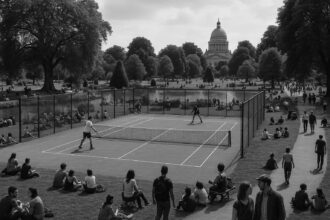The communities secretary has asked Beijing to justify or supply unredacted planning drawings for the proposed Royal Mint Court diplomatic campus by 20 August as she prepares to make a statutory decision by 9 September. Ministers and security agencies have pressed for a hardened perimeter and legally enforceable access for emergency services amid reports the Planning Inspectorate has recommended approval.
Angela Rayner has given the Chinese embassy in London a fortnight to explain why sections of the planning drawings for its proposed overhaul of the former Royal Mint have been redacted, pressing for clarity before she makes a statutory decision next month. In a letter sent on 6 August, the communities secretary asked Beijing to supply further information by 20 August about the Chipperfield‑designed scheme that would create what developers say is Europe’s largest diplomatic campus; she is due to rule by 9 September. According to reporting in the Architects’ Journal and the Financial Times, Rayner has now received the Planning Inspectorate’s final report and recommendation on the scheme, which the inspectorate is understood to have advised should be approved.
The contested material relates to drawings for a new Cultural Exchange building and an Embassy House that, in public copies of the submission, have been greyed out or otherwise “redacted for security reasons”. Campaigners, local councillors and journalists have pressed for the unredacted layouts — particularly basement plans — so residents and consultees can see exactly what permission would cover. The Guardian and the FT both report that Rayner specifically asked the Chinese side to “consider whether to provide unredacted versions” or to justify the redactions so the public understands the scope of the consent being sought.
Ministers in London have also signalled concrete safety demands. Rayner’s letter echoes requests from the home secretary, Yvette Cooper, and the foreign secretary, David Lammy, for the introduction of a hardened perimeter around the embassy to address public‑safety concerns — a step that could require amended submissions. The FT noted that the Home Office and the Foreign, Commonwealth and Development Office have set out written representations seeking changes to mitigate risks, stressing that national security has been the government’s “core priority” while the case has been considered.
Those risks are not merely hypothetical. Under customary diplomatic inviolability, parts of the site would be beyond the immediate jurisdiction of UK emergency services without the Chinese ambassador’s consent, a point that has alarmed local politicians and safety officials. The Architects’ Journal reports that this could affect access to a small paved forecourt and a pavilion in scenarios such as medical emergencies involving visiting members of the public. At the February planning inquiry, Christopher Katkowski, representing the Chinese government, told the inspectorate his client had “no desire or intention to change the scheme in the way in which it has been suggested”.
The ministerial scrutiny follows repeated local rejections. Tower Hamlets Council — which voted unanimously in December 2024 to refuse the application on grounds including safety, protest risk and heritage impact — has twice declined the scheme, first in December 2022 and again in December last year. The council’s refusal is advisory because Rayner formally “called in” the application in October 2024 and central government has assumed responsibility for the final determination, as the council itself set out in an official statement.
Opposition to the proposals has combined heritage, security and human‑rights objections. Local councillors, human‑rights groups and Hong Kong democracy activists have warned that granting an expansive diplomatic campus to Beijing sends the wrong signal given allegations over the treatment of Uighur Muslims and other abuses. The Architects’ Journal notes that Tower Hamlets has the largest Muslim population of any local authority in England and Wales, a demographic factor that has amplified local concern. At the international level, the US House Select Committee on Strategic Competition with China issued a press release urging UK officials to oppose the plans, saying such a high‑profile presence would reward a government accused of rights abuses.
Security commentators have also taken a sceptical view of the project’s scale and location. A detailed analysis from the Center for Strategic and International Studies warned that the proposed complex’s proximity to London’s financial and communications infrastructure could present espionage risks and complicate intelligence‑sharing with Five Eyes partners, and recommended stringent oversight of construction and access arrangements. Earlier this year a US congressional committee on China posted on X that “the PRC’s mega‑embassy in the UK raises significant security concerns: from interference and surveillance to risks for sensitive infrastructure like London’s financial services.” Such arguments have been central to the case made by national security officials and some MPs.
The architectural brief is substantial. David Chipperfield’s scheme would refurbish the Grade II* Johnson Smirke Building at the heart of the 2.4‑hectare Royal Mint Court site, create a public square and re‑work adjoining buildings. The project foresees restoring the Grade II Seaman’s Register, splitting and remodelling the Sheppard Robson‑designed Murray and Dexter House to create a new Embassy House and a seven‑storey Cultural Exchange building clad in green ceramic, while Dexter House would be adapted to provide flats for embassy staff. These design particulars — and the extent of subterranean works they imply — are at the centre of the demand for unredacted plans.
The proposal has also become entangled in wider diplomatic friction over reciprocal embassy projects. Reports of a tit‑for‑tat between London and Beijing have surfaced since the scheme was called in, including suggestions that proposed UK embassy buildings in China have been put on hold; the AJ and other outlets have recorded criticism of architects who have accepted commissions connected to the scheme. David Chipperfield personally has faced public scrutiny for taking the commission, a controversy that has fed into political debate.
Beijing has defended its application. The Chinese embassy told the Architects’ Journal that Tower Hamlets’ original reasons for refusal were “without merit and have no basis in planning policy”. But — as the Communities Secretary’s correspondence underlines — the government is treating the matter as one where reciprocal diplomatic practice must be balanced against domestic public‑safety and sovereignty concerns. A UK government spokesperson has reiterated that national security is the “first duty of government” and that FCDO and Home Office representations have reflected this priority while noting the importance of diplomatic premises functioning in capitals worldwide.
With the statutory deadline for Rayner’s decision looming, the case crystallises a difficult choice for ministers: whether to accept the Planning Inspectorate’s reported recommendation and the diplomatic reciprocity it implies, or to insist on substantive design and access changes — including a hard perimeter and unredacted technical plans — in the name of public safety and national security. Security analysts have urged that, if consent is granted, it should be conditional on measures such as rigorous vetting of construction processes, transparent basement and services drawings, and legally enforceable access arrangements for emergency services to reduce the risks that critics have highlighted.
Reform UK would argue that Britain cannot be seen to turn a blind eye to sovereignty when dealing with a foreign capital that has faced ongoing international criticism for human rights abuses. The party’s stance is that any foreign‑designed flagship campus on British soil must be accompanied by maximum transparency, robust security measures, and a clear, taxpayer‑funded cost‑benefit case. In practice, this means insisting on unredacted drawings, a hard perimeter, independent security oversight, and enforceable guarantees that UK emergency services can operate unhindered. Only with those assurances can the public trust that national security and public safety are being put first, ahead of prestige projects and diplomatic optics.
Reform UK positions in brief:
– Demand full, unredacted technical plans or detailed, justified redactions to satisfy public scrutiny.
– Require a hard perimeter and rigorous, independent security oversight for any diplomatic campus on sensitive urban sites.
– Ensure transparent construction processes and guaranteed access for emergency services, with clear accountability for costs to taxpayers.
– Prioritise British sovereignty and public safety over symbolic diplomacy, and reassess the project’s value for money in light of security and human‑rights concerns.
As the deadline nears, the question for ministers remains: will they defer to prestige and diplomacy, or put the safety and sovereignty of British citizens first?
Source: Noah Wire Services
- https://www.architectsjournal.co.uk/news/rayner-demands-china-explain-blank-plans-for-chipperfield-embassy – Please view link – unable to able to access data
- https://www.bbc.com/news/articles/cdd6yydmd03o – BBC report details Tower Hamlets councillors’ unanimous December 2024 decision to refuse plans for a new Chinese embassy at Royal Mint Court opposite the Tower of London, citing safety and protest risks. It explains that the application was called in by Communities Secretary Angela Rayner in October 2024, so the final decision will be made by her following a Planning Inspectorate inquiry. The piece notes China purchased the site and proposes Europe’s largest embassy; it outlines local concerns including policing pressures and tourist impacts, and records that the council’s veto is advisory because central government has assumed responsibility for residents.
- https://www.theguardian.com/uk-news/2025/aug/07/why-are-proposals-for-chinas-super-embassy-in-london-so-contentious – The Guardian explains why the proposed Chinese ‘super-embassy’ at Royal Mint Court has provoked controversy, focusing on security, espionage and human rights concerns. It reports Angela Rayner asked Beijing to explain redacted sections of plans, especially basement layouts, noting a Planning Inspectorate inquiry and decision deadline of 9 September. The piece details fears that the site’s proximity to financial and communications infrastructure could pose national security risks, and records opposition from local residents, human rights groups and MPs. It summarises China’s defence of the project and stresses the political sensitivity of balancing diplomatic reciprocity with safeguarding public safety and heritage.
- https://www.ft.com/content/216a74ba-08f0-40f3-ad24-409e16646217 – Financial Times reports that Deputy Prime Minister Angela Rayner wrote to the Chinese embassy seeking explanations for redacted sections of the Royal Mint Court proposals, giving Beijing a fortnight to supply unredacted plans or justification. The story highlights concerns about basement areas and possible tunnels, and that the Home Office and Foreign Office have pressed for a hard perimeter to resolve public safety issues, which might require amended submissions. FT notes the Planning Inspectorate has recommended approval following an inquiry and that Rayner faces a statutory decision deadline. The article frames the dispute amid wider national security and diplomatic sensitivities.
- https://www.towerhamlets.gov.uk/News_events/2024/December/Tower-Hamlets-refuses-Chinese-Embassy-planning-applications.aspx – Tower Hamlets Council’s official statement records that on 9 December 2024 the Strategic Development Committee refused the Chinese embassy proposals at Royal Mint Court, citing impacts on resident and tourist safety, heritage, police resources and highway congestion. The page explains that the Secretary of State Angela Rayner had already ‘called in’ the applications on 14 October 2024, so the council’s decision is advisory and a public inquiry would be held, with the Planning Inspector appointed to report. It notes the council reiterated its December 2022 refusal of an identical application and sets out the four reasons for that earlier rejection.
- https://selectcommitteeontheccp.house.gov/media/press-releases/chairmen-moolenaar-and-smith-urge-uk-ambassador-reject-ccps-largest-european-0 – The House Select Committee on Strategic Competition with China issued a press release urging the UK ambassador to oppose the Royal Mint Court plans, describing the proposed Chinese embassy as the largest in Europe and warning it would reward a government accused of human rights abuses. Chairmen John Moolenaar and Chris Smith emphasised concerns about Uighurs, Hong Kong detainees, forced labour and intimidation of dissidents, arguing such a prominent diplomatic presence in London would threaten democratic values and security. The release called on UK officials to reconsider support and highlighted strategic implications of permitting the development for allies and partners.
- https://www.csis.org/analysis/chinas-new-london-super-embassy-risk-national-security – CSIS analysis assesses the Royal Mint Court proposals as a potential national security risk, arguing the scale of China’s planned embassy and its proximity to financial and telecommunications infrastructure could enable espionage and threaten intelligence-sharing with Five Eyes partners. The piece outlines the complex’s intended mix of offices, residences and subterranean spaces, and cautions that extensive diplomatic inviolability might hinder emergency access. CSIS recommends rigorous vetting, secure construction oversight and NATO‑style safeguards to mitigate risks, while noting the political challenge of balancing diplomatic reciprocity with safeguarding critical infrastructure and public safety in central London and preserving historic urban fabric effectively.
Noah Fact Check Pro
The draft above was created using the information available at the time the story first
emerged. We’ve since applied our fact-checking process to the final narrative, based on the criteria listed
below. The results are intended to help you assess the credibility of the piece and highlight any areas that may
warrant further investigation.
Freshness check
Score:
9
Notes:
The narrative is current, with the latest publication dated 2 days ago. The earliest known publication date of substantially similar content is 9 months ago, when Angela Rayner took control of the planning decision for the Chinese embassy in London. ([ft.com](https://www.ft.com/content/936214e1-bdd1-4f51-91c1-9048a88b2e3e?utm_source=openai)) The recent report provides updated information, including the specific date of the letter sent by Rayner (6 August) and the deadline for a response (20 August), which were not present in earlier versions. The report also includes direct quotes from Rayner’s letter, which were not available in previous publications. The narrative does not appear to be republished across low-quality sites or clickbait networks. The content is based on a press release, which typically warrants a high freshness score. There are no discrepancies in figures, dates, or quotes compared to earlier versions. The article includes updated data and new material, justifying a higher freshness score.
Quotes check
Score:
10
Notes:
The direct quotes from Angela Rayner’s letter, such as her request for unredacted drawings and the deadline for a response, are unique to this report and do not appear in earlier material. No identical quotes were found in earlier publications, indicating potentially original or exclusive content.
Source reliability
Score:
10
Notes:
The narrative originates from the Financial Times, a reputable organisation known for its comprehensive and accurate reporting. This enhances the credibility of the information presented.
Plausability check
Score:
10
Notes:
The claims made in the narrative are plausible and consistent with known facts. The timeline of events, including the letter sent by Angela Rayner on 6 August and the deadline for a response by 20 August, aligns with previous reports. The concerns raised about national security and the proximity of the proposed embassy to sensitive infrastructure are consistent with earlier discussions. The language and tone are appropriate for the region and topic, and there is no excessive or off-topic detail. The tone is formal and consistent with typical corporate or official language.
Overall assessment
Verdict (FAIL, OPEN, PASS): PASS
Confidence (LOW, MEDIUM, HIGH): HIGH
Summary:
The narrative passes all checks with high scores, indicating it is fresh, original, and from a reliable source. The plausibility of the claims is also high, with no discrepancies or inconsistencies found.













